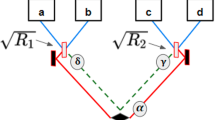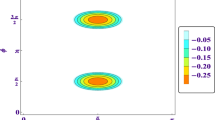Abstract
Entanglement is a random phenomenon that is instantly synchronized, regardless of the space that mediates between entangled particles. However, the instantaneous transmission of information using entanglement is impossible. This is because the instantaneity in the synchronization of non-local outcomes as a consequence of quantum measurement (after the distribution of the entangled pairs) cannot be used for an entanglement-based communication system to transmit information instantaneously. This impossibility stems from the following two reasons: (a) the difficulty of controlling non-local outcomes through local actions without the intervention of an auxiliary channel (classical), and (b) regardless of the previous point, no communication system based on entanglement can be instantaneous due to the distribution of an entangled pair at relativistic speeds, necessary to generate the quantum channel, each time a qubit must be transmitted. Three simple experiments help to clarify this controversial point. In fact, this study establishes what is truly responsible for the impossibility to transmit information instantaneously of any communication system based on entanglement. In this respect, functional models of the internal behavior of quantum measurement, and entanglement were developed, which allow analyzing the instantaneity post-distribution of entangled particles, before and after a quantum measurement, as well as the randomness in the results obtained from a quantum measurement of the entanglement. In this sense, this study establishes a debate about three possible responsible for the aforementioned randomness: the quantum measurement itself, entanglement, and the human intervention. Finally, homology between the entanglement and the double-slit experiment is presented.

































Similar content being viewed by others
Data availability
The experimental data that support the findings of this study are available in ResearchGate with the identifier https://doi.org/10.13140/RG.2.2.36266.13766.
References
Ananthaswamy, A.: Through two doors at once: the elegant experiment that captures the enigma of our quantum reality. Dutton Books, NY, USA (2018)
Arul AJ (2001) Impossibility of comparing and sorting quantum states. arXiv: 0107085
Aspect, A.: Quantum mechanics: to be or not to be local. Nature 446, 866–867 (2007). https://doi.org/10.1038/446866a
Aspect, A., et al.: Experimental realization of einstein-podolsky-rosen-bohm gedan-kenexperiment: a new violation of bell’s inequalities. Phys. Rev. Lett. 49(2), 91–94 (1982a). https://doi.org/10.1103/PhysRevLett.49.91
Aspect, A., et al.: Experimental test of bell’s inequalities using time-varying analyzers. Phys. Rev. Lett. 49(25), 1804–1807 (1982b). https://doi.org/10.1103/PhysRevLett.49.1804
Algorithmic Assertions. https://algassert.com/quirk, (accessed: March 2021).
Audretsch, J.: Entangled systems: new directions in quantum physics. Wiley, Weinheim, Germany (2007)
Banaszek K, Demkowicz-Dobrzanski R (2012) Quantum information ½. 71, June. https://www.fuw.edu.pl/~demko/Teksty/ik05/2012/qi12.pdf
Bell, J.S.: On the einstein podolsky rosen paradox. Physics 1(3), 195–200 (1964). https://doi.org/10.1103/PhysicsPhysiqueFizika.1.195
Bennett, C.H., et al.: Teleporting an unknown quantum state via dual classical and Einstein-Podolsky-Rosen channels. Phys. Rev. Lett. (1993). https://doi.org/10.1103/PhysRevLett.70.1895
Benslama, M., et al.: Quantum communications in new telecommunications systems. Wiley, Hoboken, USA (2017)
Boone, K., et al.: Entanglement over global distances via quantum repeaters with satellite links. Phys. Rev. A (2015). https://doi.org/10.1103/PhysRevA.91.052325
Boschi, D., et al.: Experimental realization of teleporting an unknown pure quantum state via dual classical and einstein-podolsky-rosen channels. Phys. Rev. Lett. 80(6), 1121–1125 (1998). https://doi.org/10.1103/PhysRevLett.80.1121
Bouwmeester, D., et al.: Experimental quantum teleportation. Nature 390, 575–579 (1997). https://doi.org/10.1038/37539
Busch, P., et al.: Quantum measurement. Springer, A.G. Switzerland (2016)
Cacciapuoti, A.S., et al.: Quantum internet: networking challenges in distributed quantum computing. IEEE Network 34(1), 137–143 (2020a). https://doi.org/10.1109/MNET.001.1900092
Cacciapuoti, A.S., et al.: When entanglement meets classical communications: quantum teleportation for the quantum internet. IEEE Trans. Comm. 68(6), 3808–3833 (2020b). https://doi.org/10.1109/TCOMM.2020.2978071
Caleffi, M., Cacciapuoti, A.S.: Quantum switch for the quantum internet: noiseless communications through noisy channels. IEEE J Select Area Communicat 38(3), 575–588 (2020). https://doi.org/10.1109/JSAC.2020.2969035
Caleffi, M., et al.: The rise of the quantum internet. Computer 53(6), 67–72 (2020). https://doi.org/10.1109/MC.2020.2984871
Caleffi M et al. (2018) Quantum internet: from communication to distributed computing! NANOCOM'18: Proc. 5th ACM Int. Confe. on Nanoscale Comp. & Comm., Reykjavik, Iceland, 1, Sept
Cariolaro, G.: Quantum communications: signals and communication technology. Springer, A.G. Switzerland (2015)
Chakraborty K et al. (2019) Distributed routing in a quantum internet. arXiv: 1907.11630
Chandra D et al (2020) Direct Quantum Communications in the Presence of Realistic Noisy Entanglement. arXiv: 2012.11982
Clauser, J.F., et al.: Proposed experiment to test local hidden-variable theories. Phys. Rev. Lett. 23(15), 880–884 (1969). https://doi.org/10.1103/PhysRevLett.23.880
Cuomo, D., et al.: Towards a distributed quantum computing ecosystem. IET Quantum Communication. 1(1), 3–8 (2020). https://doi.org/10.1049/iet-qtc.2020.0002
Dür, W., et al.: Towards a quantum internet. Eur. J. Phys. 38, 043001 (2017). https://doi.org/10.1088/1361-6404/aa6df7
Dür W, Heuslery S (2013) What we can learn about quantum physics from a single qubit. arXiv: 1312.1463
Einstein, A.: On the influence of gravitation on the propagation of light. Annln. Phys. 35, 898–908 (1911). https://doi.org/10.1002/andp.19113401005
Einstein, A., et al.: Can quantum-mechanical description of physical reality be considered complete? Phys. Rev. 47(10), 777–780 (1935). https://doi.org/10.1103/PhysRev.47.777
Ekert, A.: Quantum Cryptography. In: Sergienko, A.V. (ed.) Quantum communications and cryptography optical science and engineering. CRC Press, Boca Raton, USA (2006)
Furusawa, A., van Loock, P.: Quantum Teleportation and Entanglement: A Hybrid Approach to Optical Quantum Information Processing, Wyley-VCH, Weinheim, Germany, (2011).
Gyongyosi, L., Imre, S.: Entanglement Access Control for the Quantum Internet (2019a). arXiv: 1905.00256
Gyongyosi L, Imre S (2019b) Opportunistic Entanglement Distribution for the Quantum Internet arXiv: 1905.00258
Gyongyosi, L., Imre, S.: Entanglement accessibility measures for the quantum Internet. Quant. Info. Proc. 19, 115 (2020). https://doi.org/10.1007/s11128-020-2605-y
Hasegawa, Y., et al.: Experimental time-reversed adaptive Bell measurement towards all-photonic quantum repeaters. Nat Commun. 10, 378 (2019). https://doi.org/10.1038/s41467-018-08099-5
Hensen, B., et al.: Loophole-free Bell inequality violation using electron spins separated by 1.3 kilometres. Nature (2015). https://doi.org/10.1038/nature15759
Horodecki, R., et al.: Quantum entanglement. Rev. Mod. Phys. 81(2), 865–942 (2009). https://doi.org/10.1103/RevModPhys.81.865
Horodecki R et al. (2007) Quantum entanglement. arXiv: 07022 25
Hsu, H.P.: Fourier analysis. Simon & Schuster, New York, USA (1970)
Imre, S., Gyongyosi, L.: Advanced quantum communications: an engineering approach. Wiley, N.Y., USA (2013)
Jaeger, G.: Entanglement, information, and the interpretation of quantum mechanics. The frontiers collection. Springer, Berlin, Germany (2009)
James DFV, Kwiat PG (2006) Quantum state entanglement creation, characterization, and application. Los Alamos Science, 27, 52, August. https://permalink.lanl.gov/object/tr?what=info:lanl-repo/lareport/LA-UR-02-1236
Joy, D., et al.: Implementation of quantum secret sharing and quantum binary voting protocol in the IBM quantum computer. Quantum Inf Process (2020). https://doi.org/10.1007/s11128-019-2531-z
Kimble, H.J.: The quantum internet. Nature 453, 1023–1030 (2008). https://doi.org/10.1038/nature07127
Krenn, M., et al.: Quantum communication with photons. In: Al-Amri, M., El-Gomati, M., Zubairy, M. (eds.) Optics in our time. Springer, Cham, Switzerland (2016)
Lvovsky, A., et al.: Optical quantum memory. Nature Photon (2009). https://doi.org/10.1038/nphoton.2009.231
MacKay, D.J.C.: Information theory, inference, and learning algorithms. Cambridge University Press, Cambridge, UK (2003)
Mastriani, M., Iyengar, S.S.: Satellite quantum repeaters for a quantum internet. Quant Eng (2020). https://doi.org/10.1002/que2.55
Mastriani, M., et al.: Bidirectional teleportation for underwater quantum communica-tions. Quantum Inf. Process. 20, 22 (2021a). https://doi.org/10.1007/s11128-020-02970-5
Mastriani, M., et al.: Satellite quantum communication protocol regardless of the weather. Opt. Quant. Electron. 53, 181 (2021b). https://doi.org/10.1007/s11082-021-02829-8
Munro, W.J., et al.: Inside quantum repeaters. IEEE J Sel Top Quantum Electron (2015). https://doi.org/10.1109/JSTQE.2015.2392076
Nielsen, M.A., Chuang, I.L.: Quantum computation and quantum information. Cambridge University Press, Cambridge, UK (2004)
Lecture Notes in Physics 797: Applied Quantum Cryptography. C. Kollmitzer and M. Pivk Eds, Heidelberg, Springer (2010)
Pan, J.-W., et al.: Multiphoton entanglement and interferometry. Rev Mod Phys 84(2), 777–838 (2012). https://doi.org/10.1103/RevModPhys.84.777
Phillips, A.C.: Introduction to quantum mechanics. Wiley, Chichester, UK (2003)
Razavi M et al. (2009) Quantum repeaters with imperfect memories: cost and scalability. arXiv: 0810.5334
Ruihong, Q., Ying, M.: Research progress of quantum repeaters. IOP J. Phys. Conf. Ser. 1237, 052032 (2019). https://doi.org/10.1088/1742-6596/1237/5/052032
Sadiq M (2016) Doctor of Philosophy in Physics, Stockholm University, March. http://www.diva-portal.org/smash/get/diva2:913824/FULLTEXT02.pdf
Sangouard, N., et al.: Quantum repeaters based on atomic ensembles and linear optics. Rev Mod Phys. 83(1), 33–80 (2011). https://doi.org/10.1103/RevModPhys.83.33
Schilpp, P. A., Einstein, A.: Albert Einstein, philosopher-scientist, edited by P. A. Schilpp, Evanston, Library of Living Philosophers III, 85, Illinois, USA (1949)
Schlosshauer, M.: Decoherence, the measurement problem, and interpretations of quantum mechanics. Rev Mod Phys (2005). https://doi.org/10.1103/RevModPhys.76.1267
Shimony, A.: Controllable and uncontrollable nonlocality, in S. Kamefuchi et al., ed., Proc. of the Inter. Symp. on the Foundations of Quantum Mechanics, Tokyo, Physical Society of Japan, 225, (1984)
Thorburn, W.M.: Occam’s razor. Mind 24, 287–288 (1915). https://doi.org/10.1093/mind/XXIV.2.287
Thorburn, W.M.: The Myth of Occam’s razor. Mind 27, 345–353 (1918). https://doi.org/10.1093/mind/XXVII.3.345
Wehner, S., et al.: Quantum internet: a vision for the road ahead. Science (2018). https://doi.org/10.1126/science.aam9288
Wootters, W.K., Zurek, W.H.: A single quantum cannot be cloned. Nature 299, 802–803 (1982). https://doi.org/10.1038/299802a0
Zeilinger, A.: Light for the quantum. Entangled photons and their applications: a very personal perspective. Phys Scr (2017). https://doi.org/10.1088/1402-4896/aa736d
Acknowledgements
M. Mastriani thanks the staff of the Knight Foundation School of Computing and Information Sciences at Florida International University for all their help and support.
Funding
The authors have not disclosed any funding.
Author information
Authors and Affiliations
Corresponding author
Ethics declarations
Conflict of interest
The author declares that they have no conflict of interest.
Additional information
Publisher's Note
Springer Nature remains neutral with regard to jurisdictional claims in published maps and institutional affiliations.
Rights and permissions
About this article
Cite this article
Mastriani, M. How can a random phenomenon between particles be synchronized instantaneously and independently of the distance between said particles?. Opt Quant Electron 54, 235 (2022). https://doi.org/10.1007/s11082-022-03590-2
Received:
Accepted:
Published:
DOI: https://doi.org/10.1007/s11082-022-03590-2




